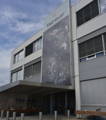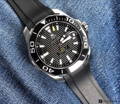WHERE ARE TAGHEUER WATCHES MADE?
Tagheuer, a name often seen on the side of F1 cars, on the wrists of world renowned sports men and women and a watch brand that most look to for their first luxury swiss watch. TagHeuer has been referred to as the ‘gateway drug’ to becoming a watch enthusiast or collector. If you either own a Tagheuer or have been into an AD to look at one, you don’t have to look any further than the bottom of the dial or case back to the words ‘Swiss Made’ proudly engraved on. Switzerland is a country that needs no introduction when it comes to watchmaking, but it’s also a very large country as well, we’re going to look at where TagHeuer watches were first started to be made and how that has changed over the course of time until today in 2022.

The beginnings of the TagHeuer watchmaking company
Founded in 1860, Edouard Heuer started making small pocket watches and soon wanted to expand into making wrist watches. Starting off in Saint-Imier, the watchmaker Heuer made all watches in one large facility. Knowing what TagHeuer is today, it might be shocking to know that theri first facility was not actually a proper watch facility, but instead it was set up on their family farm. From this facility everything was done inside to produce their watches, this included making the parts for the movement and then assembling the movements, making the case, fitting the dial and hands and so on. When Heuer first started, it was only on a small scale of production mostly for locals and to compete with their rivals which at that time would have been the likes of Omega and Rolex.
However, as Heuer began to attract more customers, producing watches out of a barn was not going to be an appropriate choice, hence in 1864 he moved their facility to a more suitable facility further north just outside Zurich in Brugg. Heuer also changed the name of the company to ‘Edouard Heuer & Compagnie’ to have a more formal name as an upgrade. Like the history of many other successful Swiss watchmakers, TagHeuer was now making more and selling more watches and demand was still on the rise. Another facility would later be opened just three years later in 1867 in Bienne.

Source : Time & TIde
Bienne is was also much closer to their family farm origins in Saint-Imier not to mention companies like Rolex and Omega also were moving and opening facilities in Bienne and TagHeuer wanted to move into an area which would later mark history as one of the greatest watchmaking towns in the world in a country associated with fine watchmaking. Tageheuer would keep their Bienne facility open longer than their other facilities.
Between their Bienne and Brugg facilities they were able to produce all their watches to their high standards and meet the demand. This would remain the case right the way through the 1900s and it was not until early 2000s when they built a new facility. As demand for TagHuer watches rose, their current facilities which they both expanded multiple times still could not cope with demand and TagHeuer wanted to innovate as well which required more technology and space.

Source : Monochrome
Hence in 2004 they built their new facility called ‘Cortech’. Cortech is located in the heart of watchmaking Switzerland, La Chaux-de-Fonds, where almost all TagHeuer movements are made and assembled. With TagHeuer being owned by the LVMH group, Tageheuer now had the financial resources to expand yet again to meet its forever growing demand. 2009 saw the expansion of Cortech to add a few new departments onto the existing building as they were now constructing more watches which required more movements to be built.
Infrastructure development for Tag Heuer

Source : SJX
Tagheuer would not stop there, only a few years later in 2010 Tagheuer bought a new pre-built facility in Chevenez, slightly further north than La Chaux-de-Fonds. This facility spans an incredible 2,600 metres squared and home to hundreds of watchmakers predominantly assembling chronograph movements whilst the other less complicated movements were benign made in La Chaux-de-Fonds.
Just one year later Taheuer opened yet another brand new watch making facility called ‘ArteCad’ which is situated in Tramelan, strategically close to their Chevenez site. This is because ArteCad is home to just over 230 watchmakers all making and constructing every dial TagHeuer needs for their watches. Once finished they can be transported to Chevenez to be added to the case with the movement to finish off the final stage of assembling the watch before being shipped out.
TagHeuer has had multiple different areas and facilities but today in 2022 they currently work from 4 facilities. Their first one is in Bienne, this one takes care of making the dial, hands and cases and their second facility, Cortech in La Chaux-de-Fonds which focuses on making all movements other than their chronographs. Cortech is also their new Headquarters since it is based in La Chaux-de-Fonds which has an incredibly rich heritage for watchmaking.
Their third facility, in Chevenz assembles all of their chronograph movements whilst their most recent facility, ArteCad in Tramelan, assembles the final part of the watch ready to be shipped out. Despite being made and designed across 4 enormous facilities, they are all based in Switzerland and gence they are all made there too!

Source : SJX
Just like TagHeuer, ZEALANDE also is manufactured in Switzerland and that’s why you can trust our rubber straps to be made to the same high standards that Swiss watch companies make their watches to. Check out our selection of rubber straps for TagHeuer' so you can choose the perfect sporty strap in our favourite colour to increase comfort whilst wearing the watch and its overall sportiness.




